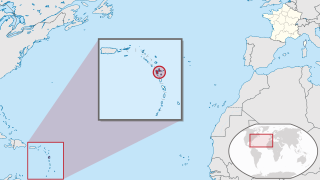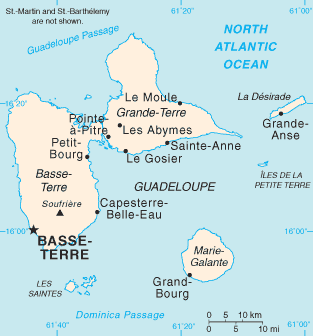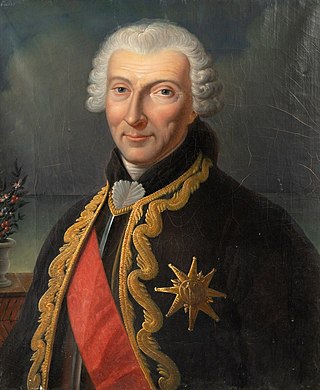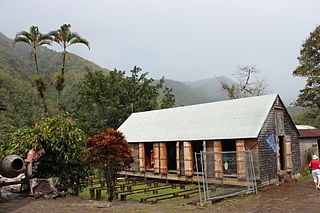
Coffee production in Guadeloupe, an overseas region of France in the Caribbean Sea, has had commercial importance at various times in its history. [1] The island's coffee heritage is being promoted through ecotourism. [2]

Coffee production in Guadeloupe, an overseas region of France in the Caribbean Sea, has had commercial importance at various times in its history. [1] The island's coffee heritage is being promoted through ecotourism. [2]
18th century In 1720, Sir Gabriel de Clieu, based in Martinique, was successful in cultivating coffee, [3] and some beans were planted on nearby Guadeloupe in 1721. [4] Coffee and cotton production increased between 1730 and 1790, decreasing reliance on sugarcane. [5] During this period, coffee cropland increased from 15 hectares to almost 7,000 hectares. [5] By the late 18th century, the cropland had spread from its principal location, at Basse-Terre, to the southwestern area of Grande-Terre. [5]
19th century In the early 19th century, the plantations that remained were mostly in higher elevations of Basse-Terre. [6] In 1842, Guadeloupe faced a coffee crisis. [7] The plantations here and in other West Indian Islands were ravaged by the larvae of Elachista Coffeella . [8] Sugarcane production gained dominance with 59% of cultivated land containing the crop in 1856, 45% in 1895, and 66% in 1939. [6] In 1891, with increased import duty on coffee, its growth got a boost. [9] However, residual coffee agriculture continued to supplement the income for some families due to the low local economic activity. The work of Jules Rossignon (died 1883) is mentioned in a Pan American Union publication in 1902. Here, Rossignon states that Guadeloupan coffee was similar to that from Martinique, not easily distinguishable, with similar price points. He described the Guadeloupe bean as "glossy, hard, and long, clean, of an even green color, somewhat grayish", and that it was exported in barrels and hemp bags. Within the "ordinary classes" of coffee, some of the grains were "smaller, rounder, and somewhat curved". Rossignon also mentions that coffee produced in Îles des Saintes was superior. [10] In 1899, Guadeloupe exported 1,587,000 pounds (720,000 kg) of coffee. [10]
20th century Commercially grown coffee varieties recorded in 1913 by Dumont were the arabica and liberica ; the former variety is of better quality and also growing in larger quantities. [11] He described production methods of the early 20th century in detail, mentioning that after the drying stage, coffee is subject to pounding and the removal of the berry's exterior brown cover, this stage being known as café habitat and that after the berry's silver coating is removed, the coffee is known as cafe bonifieur. [11] In 1918, coffee was being produced on one-ninth of Guadeloupe's land which was under cultivation and about 7% of the exports attributed to coffee. [12] By 1920, coffee cultivation had lessened. [13] Decrease in coffee production in Guadeloupe is party attributed to tropical storms; strong tropical storms of 1921 and 1928 caused severe damage to coffee trees, [14] the 1921 hurricane affecting Basse-Terre. [15] Coffee exportation in 1914 was recorded as more than 1,000 short tons-force (8,900 kN). [16]

Guadeloupe is an overseas department and region of France in the Caribbean. It consists of six inhabited islands—Basse-Terre, Grande-Terre, Marie-Galante, La Désirade, and two Îles des Saintes—as well as many uninhabited islands and outcroppings. It is south of Antigua and Barbuda and Montserrat and north of Dominica. The capital city is Basse-Terre, on the southern west coast of Basse-Terre Island; the most populous city is Les Abymes and the main centre of business is neighbouring Pointe-à-Pitre, both on Grande-Terre Island. It had a population of 395,726 in 2024.

The French West Indies or French Antilles are the parts of France located in the Antilles islands of the Caribbean:

Basse-Terre is a commune in the French overseas department of Guadeloupe, in the Lesser Antilles. It is also the prefecture of Guadeloupe. The city of Basse-Terre is located on Basse-Terre Island, the western half of Guadeloupe.

Capesterre-Belle-Eau is a commune in the French overseas region and department of Guadeloupe, in the Lesser Antilles. It is located in the south-east of Basse-Terre Island. Capesterre-Belle-Eau covers an area of 103.3 km2. The 1999 population was 19,568. The population density is 189 persons per km2. The inhabitants are called Capesterriens.

Pointe-à-Pitre is the second most populous commune of Guadeloupe. Guadeloupe is an overseas region and department of France located in the Lesser Antilles, of which it is a sous-préfecture, being the seat of the Arrondissement of Pointe-à-Pitre.

Marie-Galante is one of the dependencies of Guadeloupe, an overseas department of France. Marie-Galante has a land area of 158.1 km2. It had 11,528 inhabitants at the start of 2013, but by the start of 2018 the total was officially estimated to be 10,655, with a population density of 62.5/km2 (162/sq mi).

Le Moule is the sixth-largest commune in the French overseas department of Guadeloupe. It is located on the northeast side of the island of Grande-Terre.

Gabriel-Mathieu Francois D'ceus de Clieu was a French naval officer and the governor of Guadeloupe from 1737 to 1752 and the founder of Pointe-à-Pitre. He was awarded the rank of commander of the Royal and Military Order of Saint Louis.

Gourbeyre is a commune in the French overseas region and department of Guadeloupe, in the Lesser Antilles. It is a suburb of the city of Basse-Terre.

Vieux-Habitants is a commune on Guadeloupe, a French overseas department in the Caribbean. It is located on the southwest coast of the island of Basse-Terre.
Nicaragua produces coffee, cotton, bananas, sugar and beef cattle.
Coffee production in Haiti has been important to its economy since the early 18th century, when the French brought the coffee plant to the colony, then known as Saint-Domingue. It has been a principal crop of Haiti ever since. Alongside sugar, coffee long formed the backbone of early Haiti's economy. At the present day, coffee has fallen behind both mango and cocoa in terms of export value.

Agriculture in Martinique is an important industry. The soil of the island is extremely fertile, and the climate is tropical making excellent conditions for growing tropical fruits and other exotic plants. In the past, agriculture was the primary source of income for the island, though this has changed over recent years as demand for important exports like sugar has declined and damage to crops as a result of hurricanes has increased. At present agriculture accounts for around 6% of Martinique's GDP which ranks it far below tourism and other services, the island's primary source of revenue.
The Guadeloupe Bonifieur is a variety of coffee grown in Guadeloupe. Guadeloupe Bonifieur is the ancestor of Jamaican Blue Mountain Coffee and is very rare. The fresh air, high altitude, and abundance of rain create ideal conditions for growing this Arabica variety. The variety is called Guadeloupe Bonifieur because of its high quality and great taste, and because, in the past, it was used to enhance lower quality blends. Connoisseurs consider it one of the best coffees in the world, even though it is only available from a few distributors.

Rhum agricole is the French term for sugarcane juice rum, a style of rum originally distilled in the French Caribbean islands from freshly squeezed sugarcane juice rather than molasses. Rhum is the term that typically distinguishes it in French-speaking locales from the rum made with molasses in other parts of the West Indies.

The coffee production in Honduras played a role in the country's history and is important for the Honduran economy. In 2011, the country became Central America's top producer of coffee.
The production of coffee in Paraguay began in the late 19th century. Plantations were known at that time near Asunción and Limpio.
Coffee production in the Dominican Republic is based mainly in the mountain regions of the country, in the highlands which form at least one-half of the area of Hispaniola. Introduced to the country in 1715, the Dominican Republic bean is larger and thicker than Martinique's. The major coffee variety grown in the country is Arabica. Robusta is also grown but only in about 1.3% of the land area; it is consumed locally.

Coffee production in Martinique dates to 1723 and its establishment is credited to the French naval officer Gabriel de Clieu. It later spread to other places in the Caribbean and South America from Martinique, an overseas region of France.

Habitation La Grivelière is a coffee plantation and coffeehouse in Vieux-Habitants, Basse-Terre, Guadeloupe, an overseas region of France. Founded in the late 17th century, it has been classified as a Monument historique since 1987. The plantation is located along the Grande Rivière des Vieux-Habitants within the Guadeloupe National Park, at 200 meters (660 ft) above sea level. It operates under the auspices of Association Verte Vallée. One of the buildings has been re-purposed into a coffeehouse. It is one of the best preserved agricultural estates in the Lesser Antilles. Habitation La Grivelière contains a dozen buildings including a manor house, overseer's house, houses of permanent workers, two boucans, a roasting shed, mills, an oratory and five slave huts.